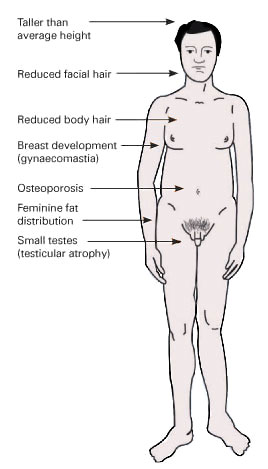Klinefelter syndrome

The karyotype of a normal human male is 46XY[1]. If an individual has two or more X chromosomes then he is said to have Klinefelter syndrome[2]
Symptoms
An individual with Kleinfelter syndrome has a male phenotype [3], however they also possess a number of traits which are absent in a karyotypically normal male which are symptomatic of the disorder, these include:
- Reduced body hair growth i.e less chest and armpit hair growth than a normal male with less facial hair growth
- Development of breast tissue
- Usually tall
- Small testicles
- Lack of sexual maturation so individuals are usually sterile (dont produce sperm)
Cause
Normally sex chromosomes undergo segregation during Meiosis in gamete producing cells so each daughter cell contains one sex chromosome[6]. However if this fails to occur gametes can be produced with an abnormal number of sex chromosomes (i.e in the case of Klinefelter syndrome an egg cell is produced with two X chromosomes) this process is called nondisjunction. If such a gamete is fertilised the resulting offspring will in turn have an abnormal number of sex chromosomes, which in this case causes Klinefelter syndrome, though a number of other genetic disorders exist caused by other sex chromosome abnormalities such as Turner syndrome (45,X). [7]
Variants
Although 47,XXY is the most common karyotype for individuals with Klinefelter syndrome a number of other aberrant karyotypes can cause Klinefelter syndrome. These include 48,XXXY, 48,XXYY and 49,XXXXY.[8]
References
- ↑ p176.Passarge E.,2007,Color atlas of genetics. 3rd ed.Ludwigsburg: Thieme.
- ↑ National Centre for Biotechnology Information, 2011,Pub Med (online)Available at <http://www.ncbi.nlm.nih.gov/pubmedhealth/PMH0001420/> [accessed 19th November 2011]
- ↑ p269,Hartl,D.L et al, 20009. Genetics Analysis of Genes and Genomes. London,Jones and Bartlett
- ↑ National Centre for Biotechnology Information, 2011,Pub Med (online)Available at <http://www.ncbi.nlm.nih.gov/pubmedhealth/PMH0001420/> [accessed 19th November 2011]
- ↑ Image of Klinefelter suffer taken from Andrology Australia, November 2005.Available at <http://www.andrologyaustralia.org/pageContent.asp?pageCode=KLINEFELTERSSYNDROME#WHATARETHEEFFECTSOFK> [accessed 19 November 2011]
- ↑ p268,Hartl,D.L et al, 20009. Genetics Analysis of Genes and Genomes. London,Jones and Bartlett
- ↑ p269,Hartl,D.L et al, 20009. Genetics Analysis of Genes and Genomes. London,Jones and Bartlett
- ↑ National Centre for Biotechnology Information, 2011,Pub Med (online)Available at http://www.ncbi.nlm.nih.gov/pubmed/21540567 [accessed 19th November 2011]